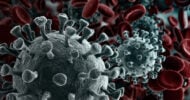by David Edelman, MD
Heartburn and acid reflux disease are common problems affecting women of all ages. The problem develops when acid in the stomach backs up into the esophagus. There is a muscle known as the diaphragm that separates the chest from the abdominal cavity. When you eat or drink, the food goes from the mouth down the esophagus, through the diaphragm and into the stomach. Eating too fast and too much causes the esophagus to distend, which over time stretches the opening in the diaphragm. This causes a widening of the diaphragm muscle opening known as a hiatal hernia. This can lead to the symptom of heartburn.
Obesity is a contributing factor to causing a hiatal hernia since the increase in weight on the abdomen pushes on the stomach and causes the acid to back up. Pregnancy has a similar effect and is the major factor why this condition is more frequent in women. Genetics is another common cause. Other dietary issues that increase the cause of gastroesophageal reflux disease, know as GERD, are caffeine in coffee and sodas and nicotine from tobacco. Heartburn, GERD, reflux and hiatal hernia are similar names for the same condition.
The treatment is initially medication taken by mouth. Some of the common medications prescribed are Tagament, Zantac, Pepcid, Prilosec, and Protonix, among others. If medications do not control the heartburn, surgery may be necessary. Twenty years ago, the surgery was done using a large incision in the upper abdomen. It was painful and resulted in a four to six week recovery. In the 1990s, laparoscopic surgery was introduced and the surgical recovery was dramatically shortened. However, at the same time, newer medications came on the market which were better able to control the symptoms of heartburn and problems associated with GERD.
Then in early 2000, biologic surgical mesh was introduced and was added to repair the tear in the diaphragmatic muscle in patients with GERD. The biologic mesh enhanced the operation and made the long-term results better. As the body recognizes the material as natural tissue, the graft communicates with the body, signaling surrounding tissue to grow across the scaffold. This action supports the healing process by attracting cells and nutrients to the area. The body begins to use the scaffold to heal the tear in the muscle. Over time, the biologic graft completely remodels into strong, fully vascularized tissue. As a result, patients experience a quick and efficient recovery period, typically returning to their normal, daily activities within two to three weeks of the surgery.
The advantage of using a biologic material is that the body accepts the treatment more quickly, thus accelerating the healing process. The biologic graft remodels to become as strong as the patient’s own tissue. Once the healing process is complete, the material is undetectable – providing a permanent repair. In contrast, synthetic surgical meshes become very tough and stiff within the body. They are not used in the repair of hiatal hernias because they are so stiff, they often tear and erode into the stomach and esophagus, causing serious side effects which necessitate further extensive and dangerous surgery. The biologic mesh does not cause these problems.
Although laparoscopic surgery utilizing biologics can offer exceptional results for any woman who has a hiatial hernia, the procedure may not be appropriate for everyone. In many cases, medications, diet and weight loss can help to alleviate the symptoms of heartburn. Nevertheless, surgery has consistently shown to be the most effective treatment for repairing a hiatal hernia. It is recommended that you see a gastroenterologist or a laparoscopic surgeon familiar with the treatment of heartburn before you consider medication or surgery for this condition.
David Edelman is the general surgeon for the Miami Heat basketball team and practices at Doctors Hospital in Coral Gables, Florida.
Submit a guest post and be heard.











![Working patients and health care [PODCAST]](https://www.kevinmd.com/wp-content/uploads/Working-patients-and-health-care-190x100.jpg)
![Supporting medical resident families [PODCAST]](https://www.kevinmd.com/wp-content/uploads/Supporting-medical-resident-families-190x100.jpg)

![A tribute to primary care [PODCAST]](https://www.kevinmd.com/wp-content/uploads/A-tribute-to-primary-care-190x100.jpg)
![Biotechnology and biological warfare [PODCAST]](https://www.kevinmd.com/wp-content/uploads/Biotechnology-and-biological-warfare-190x100.jpg)
